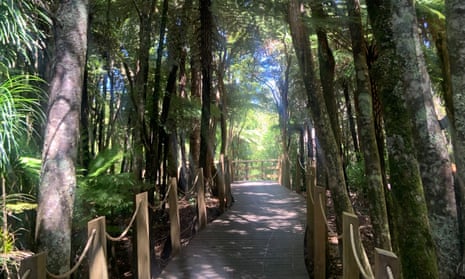The lush Waitākere Ranges that line the western ridge of Auckland City, known as Tāmaki Makaurau, are home to some of the country’s most precious native flora, including Aotearoa New Zealand’s hallowed native tree, the kauri (Agathis australis).
For more than five years, many walking tracks that lace through dense forest covering these hills have been closed to the public, placed under rāhui (a cultural ban on human entry) in a race against time to save the trees from kauri dieback, a devastating pathogen irreversibly destroying the population.
Just two percent of kauri forest remains; nearly wiped out through logging during the early to mid colonial era. Ecologically, the forest is significant; it’s the last refuge for a number of rare species, including Pekapeka, the native bat, and hosts some of the most significant old-growth kauri remaining within the city’s province.
The rāhui, conservation experts say, has paid off, with the pause from human interference allowing for a reopening of parts of the popular regional park that spans about 17,000 hectares.
Auckland Council’s team leader on kauri dieback, Sarah Killick, says the reopening of the Cascade Kauri track represents a significant milestone, where the council and the local iwi (tribe) Te Kawerau ā Maki, which holds territorial rights to the land, worked in partnership on innovative conservation efforts in a region at the coalface of the fight against the disease.
Those efforts included a mass-scale survey across the terrain that hosts at least 69,000 kauri over 15 metres tall, and countless seedlings, including by remote sensing. That meant human access to the forest wasn’t required to identify kauri trees and monitor change over time. Sniffer dogs were also trained to smell the soil-borne pathogen, Phytophthora agathidicida, which causes kauri dieback.

For the wider public – about 800,000 people once visited the grounds each year – the reopening brings cause for celebration, but for others the success, while worth celebrating, comes shaded with caution.
Auckland Council’s senior kauri dieback ranger Stuart Leighton stands before the towering Aunt Agatha, stripped of her bark and estimated at more than 1,000 years old; a dead symbol of the devastation wrought by the disease.
Kauri take hundreds of years to grow, and an equal number to die; their parched-white trunks will finally crumple into the earth. Inscribed into the wooden railing around a viewing platform is a Whakataukī (proverb): ‘Chiefly trees/standing tall in the forest/without you/who will greet the sun?’.
There was a desire to acknowledge what had happened here, Leighton says. “This may be something kauri recover from or it may be a horrible combination of climate change and a pathogen able to thrive in that climate.”
A reconception of time is required, Leighton says. “You have to think of a 1000-year plan, and of adaptive management – it’s not a fixed response”. “The challenge that Te Kawerau ā Maki put in front of us was to build tracks with the ability to come back in 100 years and remove that infrastructure having left a tiny footprint”.

Ed Ashby, CEO of Te Kawerau ā Maki Trust, has mixed feelings about the reopening of the reserve. Large swathes of West Auckland land once belonged to the iwi, and after its confiscation by the Crown what remains is too precious to risk further losses.
“These living ancestors, some of whom are so old they watched the first waka [canoes] turn up on our shores, watched the entire history of these islands. We’re duty bound to do something, and rāhui is one of the gruntier conservation tools in te ao Māori, so that’s what we needed to do.”
While the rāhui is technically still in effect over the forest, the iwi recognised the pressure valve of public demand for re-opening.
“It’s bittersweet. It’s good to celebrate it, lots of hard work and investment went into it, but there’s also a deeper maemae, or hurt, for us opening these things – and it’s scary.”
For now, the rāhui will remain until there are adequate signs the forest is healing, not just holding the line, he says, and there are plans to open more tracks in the coming months.
This article was amended on 2 February 2024 to remove an agency picture that was incorrectly captioned as showing a tree named Tāne Mahuta, and to correct a reference to fauna instead of flora.

Comments (…)
Sign in or create your Guardian account to join the discussion